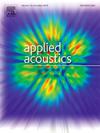Simulation and design of T-shaped barrier tops including periodic split ring resonator arrays for increased noise reduction
IF 3.4
2区 物理与天体物理
Q1 ACOUSTICS
引用次数: 0
Abstract
Road traffic flows are increasing and so are associated noise levels along highways. Simply increasing the height of conventional noise barriers is not a sustainable way of meeting the greater requirements for noise control. This paper reports the design of two types of structures involving either horizontal or vertical cylindrical split ring resonators placed on a T-shaped noise barrier to improve its acoustical performance. These structures exploit mechanisms of Bragg scattering, cavity resonance, and sound absorption by cylindrical microperforated plate inserts. The designs are based on 2D and 3D finite element models and measured frequency spectra of highway noise. They have been validated by full scale tests in a semi-anechoic laboratory. The structures with uniformly reducing numbers of horizontal resonators in successive rows and uniformly reducing heights in successive rows of vertical resonators are found to offer the best overall noise reduction. Microperforated cylindrical inserts are found to increase the reduction offered by the horizontal resonator arrangements by 5 dB near 2 kHz, while having little effect on the performance of the arrays of vertical resonators.
求助全文
约1分钟内获得全文
求助全文
来源期刊

Applied Acoustics
物理-声学
CiteScore
7.40
自引率
11.80%
发文量
618
审稿时长
7.5 months
期刊介绍:
Since its launch in 1968, Applied Acoustics has been publishing high quality research papers providing state-of-the-art coverage of research findings for engineers and scientists involved in applications of acoustics in the widest sense.
Applied Acoustics looks not only at recent developments in the understanding of acoustics but also at ways of exploiting that understanding. The Journal aims to encourage the exchange of practical experience through publication and in so doing creates a fund of technological information that can be used for solving related problems. The presentation of information in graphical or tabular form is especially encouraged. If a report of a mathematical development is a necessary part of a paper it is important to ensure that it is there only as an integral part of a practical solution to a problem and is supported by data. Applied Acoustics encourages the exchange of practical experience in the following ways: • Complete Papers • Short Technical Notes • Review Articles; and thereby provides a wealth of technological information that can be used to solve related problems.
Manuscripts that address all fields of applications of acoustics ranging from medicine and NDT to the environment and buildings are welcome.
 求助内容:
求助内容: 应助结果提醒方式:
应助结果提醒方式:


